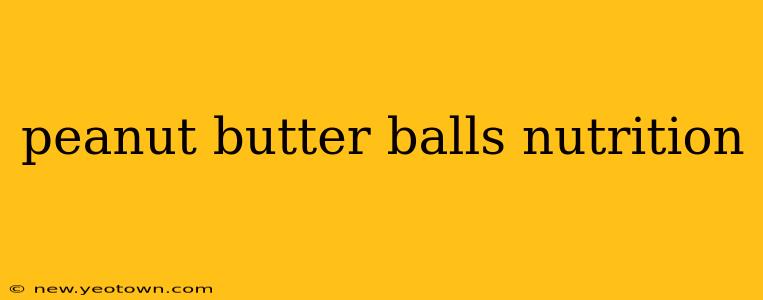Peanut butter balls – those delightful little no-bake confections – are a childhood favorite for many. But how healthy are they, really? Let's dive into the nutritional information and explore some common questions surrounding this beloved snack. Imagine biting into a perfectly formed peanut butter ball, the smooth, creamy peanut butter melting in your mouth, the sweetness balancing the nutty flavor… delicious! But before you indulge, let's explore the nutritional facts.
The nutritional content of a peanut butter ball can vary significantly depending on the recipe. A typical homemade peanut butter ball, roughly 1 inch in diameter, might contain ingredients like peanut butter, powdered sugar, butter, and sometimes oats or chocolate chips. This variation makes a precise nutritional profile difficult to state definitively. However, we can provide a general overview and address common questions.
What are the main ingredients in peanut butter balls?
The core ingredients are usually peanut butter, powdered sugar, and butter. These provide the creamy texture and sweet flavor. Many variations add oats for a bit of chewiness and fiber, while chocolate chips add extra richness and sweetness. Some recipes even incorporate other nuts or dried fruits for added flavor and nutrients.
How many calories are in a peanut butter ball?
This depends heavily on the recipe and size. A typical homemade peanut butter ball might contain anywhere from 100-150 calories. Larger balls, or those made with ingredients like chocolate chips or extra butter, will naturally have more calories. If you're watching your calorie intake, it's best to make smaller balls and be mindful of the ingredients you use.
Are peanut butter balls high in fat?
Yes, peanut butter balls are relatively high in fat, primarily from the peanut butter and butter content. However, much of this fat is unsaturated fat, which is considered a healthier type of fat. It’s important to remember that fats are a necessary part of a balanced diet, but moderation is key. Don't let the fat content scare you completely; just enjoy them in moderation as part of a balanced dietary approach.
What are the other nutritional benefits of peanut butter balls (if any)?
While not a nutritional powerhouse, peanut butter balls do offer some benefits. The peanut butter provides protein and healthy fats, as well as some vitamins and minerals. Oats, if included, boost the fiber content, which aids digestion. The nutritional profile is ultimately influenced by the ingredients used.
Are peanut butter balls a good source of protein?
Peanut butter balls provide a moderate amount of protein, thanks to the peanut butter. The exact amount varies depending on the recipe and the size of the ball, but it contributes to feelings of fullness and aids in muscle repair and growth.
Can I make healthier peanut butter balls?
Absolutely! There are many ways to make healthier versions of peanut butter balls. Consider using:
- Natural peanut butter: Avoid added sugar and hydrogenated oils.
- Less powdered sugar: Reduce the amount or substitute with a healthier sweetener like honey or maple syrup. (Be aware that this will affect the texture.)
- Whole wheat oats: Adds fiber and nutrients.
- Unsweetened cocoa powder: For a chocolatey flavor without the added sugar of chocolate chips.
By making these simple swaps, you can significantly improve the nutritional profile of your peanut butter balls while still enjoying their delicious taste. Remember, even healthier versions should still be consumed in moderation.
Making peanut butter balls at home allows for greater control over the ingredients and their proportions. This way you can indulge in your favorite treat while making conscious choices to align with your dietary needs and preferences. So, grab your ingredients and bake (or rather, no-bake) a batch of these delightful treats responsibly!

